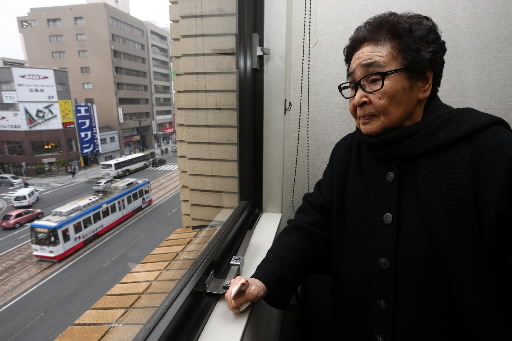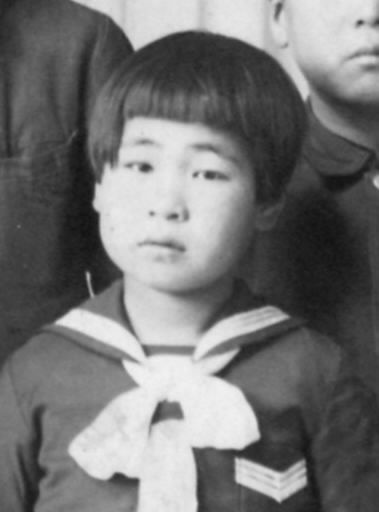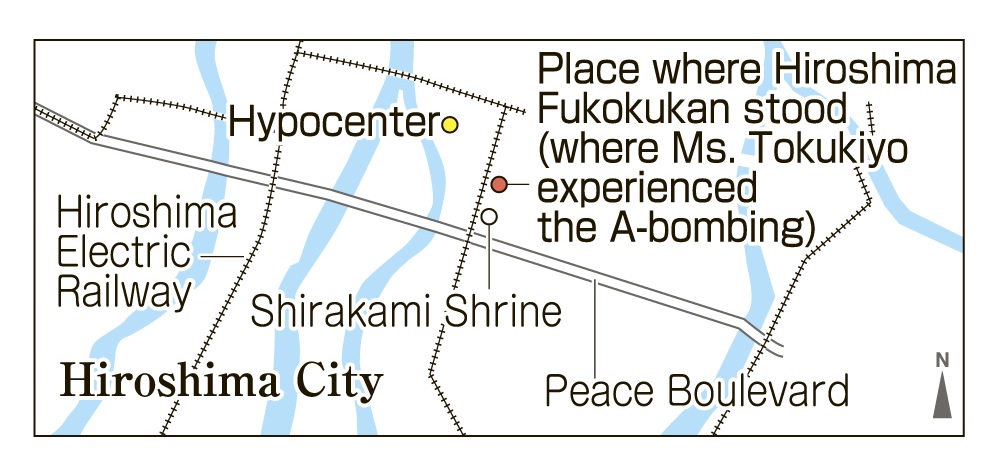Hiroko Tokukiyo, 82, Nishi Ward, Hiroshima
Aug. 8, 2012
Crawling to safety, hovering between life and death
Suffered A-bombing from a distance of 330 meters, body still embedded with glass
Hiroko Tokukiyo (nee Nakaya), 82, experienced the atomic bombing at a building called Hiroshima Fukokukan, located in today’s Naka Ward and situated only 330 meters from the hypocenter. Standing in the same place is now the Fukoku Seimei building. For this interview, Ms. Tokukiyo returned to that spot for the first time since August 6, 1945. “When I close my eyes, I can recall that day,” she said, wiping away tears. “War is so terrible.”
Ms. Tokukiyo was 15 years old at the time of the bombing. She was working in the Hiroshima Telegram Office, located in the Hiroshima Fukokukan building, when the blast occurred. She was talking with a woman on the fourth floor when, as she recalls, “There was a roaring sound, hitting my ears like the ripples in water when a stone is thrown in the river--and then nothing more.” When she came to, the darkness of dust and soot was swirling around her. She touched her face and found it sticky--she realized her head was bleeding.
She doesn’t remember how she managed to exit the building. She then fled for her life in the direction of her house in Ujina, part of present-day Minami Ward. Along the way, someone grabbed her leg and tugged her backward. She fell and wasn’t able to stand up again. “Probably because a piece of concrete jabbed into my right ankle,” she explained. At that point she could only crawl, continuing this way until she reached Shirakami Shrine, located nearby.
She saw people who no longer looked human, Ms. Tokukiyo said, with their internal organs protruding from their bodies or their skin and flesh peeled away and drooping down.
Afterward, the black rain began to fall. She wasn’t aware that the rain contained radioactive elements, and while drinking it, thinking the water was “a blessing from God,” she fell unconscious.
It was nearly evening when she came to. As she was crying and screaming for her mother, a man searching for his own daughter passed by and the man stopped to help Ms. Tokukiyo.
He gave her a ride on the back of his bicycle. En route to her house, she came across her mother, Ishino, and her brother, Teruzo, who were out looking for her. But because her face was bloody, her mother couldn’t recognize her. Ms. Tokukiyo called her brother’s name and then he realized it was his sister: “That’s Hiroko’s voice! Hiroko is alive!” They were overjoyed to find her.
After returning home, Ms. Tokukiyo again fell unconscious. She became delirious, murmuring “water, water” or “the fire is approaching.” The doctor who examined her told her family she wouldn’t live longer than a couple of months. Other symptoms included hair loss, bleeding gums, and even blood seeping from the pores of her skin. Her mother resorted to feeding her water and rice porridge from her own mouth.
Even today, numerous glass fragments are still embedded in Ms. Tokukiyo’s body. Though she has suffered illnesses, including cancer, she has been blessed with four grandchildren. “Be kind to others and live a moral life,” she said. “Hiroshima was reborn from a burnt plain and it’s now a beautiful city. Let’s keep it that way.” (Sakiko Masuda, Staff Writer)
Hiroshima Insight: Hiroshima Fukokukan
107 people in the telegraph office become A-bomb victims
Hiroshima Fukokukan was a seven-story building with a basement. Built in 1936 in Fukuromachi, part of downtown Hiroshima, it was the tallest building in the city back then. The building was home to such businesses as an insurance company and a restaurant called “Seiyoken.”
In June 1945, the Hiroshima Telegraph Office, formerly a unit of NTT West Japan, moved its operations into five floors, as well as the basement, of the Hiroshima Fukokukan building. Because the telegraph office was responsible for transmitting air raid sirens and telegram and telephone communications, the Japanese military ordered that it be relocated to a strongly-constructed site. According to Hiroshima Peace Memorial Museum, out of the 117 staff members assigned to the telegraph office, 107 perished in the atomic bombing.
The Hiroshima Fukokukan building remained standing, but all the floors above ground were gutted by fire. After the building was renovated, it was used until 1982, when it was finally torn down. Today, the Fukoku Seimei building rises from that location.
A steel beam from the Hiroshima Fukokukan building, snapped and badly bent by the A-bomb blast, as well as decorative stones that once adorned the roof, are on display in Peace Memorial Museum to convey the powerful force unleashed by the bomb.
Teenagers' Impressions
More frightening than I imagined
The horror witnessed by Ms. Tokukiyo, not far from the hypocenter, was hundreds of times more terrible than the display at Peace Memorial Museum with the wax figures [showing the survivors in the aftermath of the atomic bombing]. I felt more frightened than I had expected. But like the man who helped Ms. Tokukiyo in that dreadful situation, I want to be the kind of person who’s willing to help others under any conditions. (Yuka Iguchi, 17)
Handing down the A-bomb experiences
Ms. Tokukiyo saw people with their skin and flesh hanging from their bodies and someone who had lost an arm. She said they no longer even appeared to be human. When she was telling her story, I imagined the cruel scenes she saw near the hypocenter. Despite encountering such painful things, she bravely recounted her experiences to us. We want to hand down those experiences to the next generation, so no one else will have to suffer like that. (Mako Sakamoto, 15)
Staff Writer’s Notebook
“I tell my mother, now passed on, that I’m proud of my path in this life.” Ms. Tokukiyo recently wrote this haiku as she thought of her mother, who died of cancer in 1958. On August 6, 1945, her mother went searching for her, after Ms. Tokukiyo suffered the atomic bombing 330 meters from the hypocenter, and then took great care of her. One place which reminds Ms. Tokukiyo of her mother is Shirakami Shrine, where a man stopped to help her. The shrine still stands along Peace Boulevard. During the war, Ms. Tokukiyo’s mother was working near Shirakami Shrine and she often visited the shrine to pray for her daughter’s health and safety. “Thanks to my mother, I was able to survive the bombing,” Ms. Tokukiyo said. With the 67th summer since the attack now looming, Ms. Tokukiyo joined her hands together in a peaceful prayer at the shrine, standing under a tree of cherry blossoms in full bloom. (Sakiko Masuda)
(Originally published on April 23, 2012)










